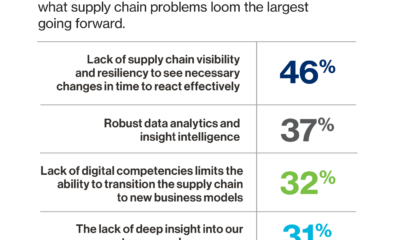Politics
Digital Transformation in Supply Chain Management
Published
2 years agoon
By
Drew Simpson
In order to achieve a competitive edge in today’s global marketplace, businesses can use digital transformation in supply chain management to maximize efficiency, increase quality and consistency, and better serve their customers. In addition, it guarantees that the supply chain will become more flexible and adopt efficient business models soon.
Undoubtedly, manual and paper-based processes can be automated by converting analog to digital forms. The supply chain will undergo a massive transformation over five to ten years. In today’s supply chains, marketing, product development, distribution, and customer service are separate and distinct.
Role of Digital Transformation Companies
Today, various digital transformation companies transform the world, tearing down barriers and establishing a fully integrated ecosystem entirely upfront to all people involved. Supply chain management, analytics, robots, and even 3D printing will be critical components of this ecosystem and several other digital technologies.
Further, the rapid digitization of supply chains will increase efficiencies in developing new economic models and revenue streams. However, offering digital transformation services in supply chain management can be complex, but this article will explain everything about it. Let’s get started! Shall we?
About Digital Supply Chain
A supply chain is a network of people, businesses, resources, operations, and technology that work together to make and sell a product, from the supplier who sends the raw materials to the manufacturer to the person who buys the product. During Supply Chain Management, documents or invoices that two people exchange for goods or services are digitalized when shared between them.
When it comes to digitizing the supply chain, there are a lot of tools that can help make it easier and more efficient. The main objective of the digitalization of the supply chain is to enable greater productivity and profitability. And digital supply chain transformation allows companies to move resources, people, and assets to where they are necessary at any provided time, reducing costs by anticipating and responding to transportation and manufacturing risks.
How does Digital Transformation play a role in Supply Chain Management?
The following are vital digital transformation roles in supply chain management:
1. Enable a demand-driven supply chain
Digital systems enable demand-driven supply chain management. Various digital transformation companies can use real-time sales data from digital technology to adjust the supply chain to meet the demand for specific products better, allowing them to speed up the production of top-selling items while cutting costs on underperforming ones.
2. Become more proactive in our approach
Without a doubt, one of its most significant advantages is the ability of the company to begin to think ahead and move more forward. Besides focusing solely on the past, the company’s efficiency and performance can be improved by adopting the opposite approach.
3. Reducing markdowns and stockouts
For companies to have the right product mix and attract customers, they need to optimize lead times and respond to consumer demand. Sales are lost because of price reductions, which eat away at profits dollar for dollar and shortages of products.
4. Use of data visualization
Every day, a massive amount of data becomes available, as you’re probably aware. As a result, many companies cannot effectively handle and organize this data. Using data visualization, you can easily see what is going on in your company’s various departments in a way that is easy to understand. Using this data, you can pinpoint areas that need improvement and become more efficient.
5. Improve cash flow and cost management.
Digitizing your supply chain management processes has the critical benefit of reducing the amount of capital invested in the supply chain as it moves faster.
6. Increase the level of clients satisfaction
A company’s primary objective is to ensure that its clients are satisfied with the products or services they receive. As a result, you’ll better serve your customers with a digital supply chain. And supply chain changes can be made more quickly; your customers will be happier because you will deliver exactly what they want and need faster.
Digital Supply Chain Management Trends
Supply Chain Management uses sensors, robotics, big data, Internet-of-Things technologies, and the chain as a whole to achieve consumer attraction through automated processes. In addition to speeding up the process, it also allows for greater adaptability, efficiency, and precision in the supply chain.
Following are the few most prominent trends:
1. The Internet of Things (IoT) Technologies
Things connected to the internet are known as “Internet of Things” or IoT technologies. The Internet of Things (IoT) makes it possible to identify and track products in warehouses and stores, monitor delivery performance, and regulate and measure facility temperature and relative humidity. RFID (radio-frequency identification) and GPS (global positioning system) are examples of technologies used to monitor and analyze inventory, cargo, and vehicles.
2. Blockchain
For the past few years, the term “blockchain” has become associated with cryptocurrencies like bitcoin. In the end, it’s a helpful tool for securely transferring paper and digital documents, such as ledgers, collective bargaining agreements, and quality diplomas. Documents relating to freight can generate every step of the supply chain. Because each transaction records its own block, a complete history of all transactions can be traced back to a single point in time.
3.Robotics
Robotics is being used in the retail and logistics industries to reduce the time it takes to get goods from one place to another. They’re known as inventory robots and can work in warehouses. Usually, they can take inventory from the shelf and either repackage or move it around. Deliveries can be made by drones or driverless cars. In addition, customer service robots are also available in stores to assist the customer and respond to their queries.
4. Cloud Framework
Expenditures on cloud computing expect to reach a high peak as various sectors of the economy continue to embrace more effective solutions. Solutions for supply chains, cloud-based infrastructures, and cloud-based systems are used in supply chain management. Fortunately, supply chain management is becoming more efficient thanks to cloud-based storage, analysis, inventory tracking, and monitoring solutions.
5. Utilizing big data and advanced analytics
Many valuable insights generate throughout the supply chain, from inventory planning through manufacturing and sales. Most of the time, the information gathered is used in making decisions. These include sales forecasting, inventory control, and operational optimization.
Final Verdict
By embracing digital transformation today, an organization can keep up with changing customer demands—an organization’s ability to compete in an ever-changing economic landscape enhanced by digital transformation. As a result, any company, nonprofit, or institution hoping to thrive in the future must undergo digital transformation. Businesses that refuse to undertake digital transformation will eventually go out of business.
Undoubtedly, the supply chain will grow and develop in the future, promoting innovation, competition, and customer service. Companies must keep improving inventory and asset management by using automated warehouses in a competitive market. Therefore, a rise in revenue is almost unavoidable as long as companies continue to pour money into innovation.
You may like
-


This viral game in China reinvents hide-and-seek for the digital age
-


The Download: digital hide-and-seek, and AI for African languages
-


RSV is on the rise but preventative drugs are in short supply
-


Unlocking supply chain resiliency
-


AI-powered 6G networks will reshape digital interactions
-


How AI is Changing Data Management: Embracing the AI-Driven Automation Era
Politics
Fintech Kennek raises $12.5M seed round to digitize lending
Published
6 months agoon
10/11/2023By
Drew Simpson
London-based fintech startup Kennek has raised $12.5 million in seed funding to expand its lending operating system.
According to an Oct. 10 tech.eu report, the round was led by HV Capital and included participation from Dutch Founders Fund, AlbionVC, FFVC, Plug & Play Ventures, and Syndicate One. Kennek offers software-as-a-service tools to help non-bank lenders streamline their operations using open banking, open finance, and payments.
The platform aims to automate time-consuming manual tasks and consolidate fragmented data to simplify lending. Xavier De Pauw, founder of Kennek said:
“Until kennek, lenders had to devote countless hours to menial operational tasks and deal with jumbled and hard-coded data – which makes every other part of lending a headache. As former lenders ourselves, we lived and breathed these frustrations, and built kennek to make them a thing of the past.”
The company said the latest funding round was oversubscribed and closed quickly despite the challenging fundraising environment. The new capital will be used to expand Kennek’s engineering team and strengthen its market position in the UK while exploring expansion into other European markets. Barbod Namini, Partner at lead investor HV Capital, commented on the investment:
“Kennek has developed an ambitious and genuinely unique proposition which we think can be the foundation of the entire alternative lending space. […] It is a complicated market and a solution that brings together all information and stakeholders onto a single platform is highly compelling for both lenders & the ecosystem as a whole.”
The fintech lending space has grown rapidly in recent years, but many lenders still rely on legacy systems and manual processes that limit efficiency and scalability. Kennek aims to leverage open banking and data integration to provide lenders with a more streamlined, automated lending experience.
The seed funding will allow the London-based startup to continue developing its platform and expanding its team to meet demand from non-bank lenders looking to digitize operations. Kennek’s focus on the UK and Europe also comes amid rising adoption of open banking and open finance in the regions.
Featured Image Credit: Photo from Kennek.io; Thank you!
Radek Zielinski
Radek Zielinski is an experienced technology and financial journalist with a passion for cybersecurity and futurology.
Politics
Fortune 500’s race for generative AI breakthroughs
Published
6 months agoon
10/11/2023By
Drew Simpson
As excitement around generative AI grows, Fortune 500 companies, including Goldman Sachs, are carefully examining the possible applications of this technology. A recent survey of U.S. executives indicated that 60% believe generative AI will substantially impact their businesses in the long term. However, they anticipate a one to two-year timeframe before implementing their initial solutions. This optimism stems from the potential of generative AI to revolutionize various aspects of businesses, from enhancing customer experiences to optimizing internal processes. In the short term, companies will likely focus on pilot projects and experimentation, gradually integrating generative AI into their operations as they witness its positive influence on efficiency and profitability.
Goldman Sachs’ Cautious Approach to Implementing Generative AI
In a recent interview, Goldman Sachs CIO Marco Argenti revealed that the firm has not yet implemented any generative AI use cases. Instead, the company focuses on experimentation and setting high standards before adopting the technology. Argenti recognized the desire for outcomes in areas like developer and operational efficiency but emphasized ensuring precision before putting experimental AI use cases into production.
According to Argenti, striking the right balance between driving innovation and maintaining accuracy is crucial for successfully integrating generative AI within the firm. Goldman Sachs intends to continue exploring this emerging technology’s potential benefits and applications while diligently assessing risks to ensure it meets the company’s stringent quality standards.
One possible application for Goldman Sachs is in software development, where the company has observed a 20-40% productivity increase during its trials. The goal is for 1,000 developers to utilize generative AI tools by year’s end. However, Argenti emphasized that a well-defined expectation of return on investment is necessary before fully integrating generative AI into production.
To achieve this, the company plans to implement a systematic and strategic approach to adopting generative AI, ensuring that it complements and enhances the skills of its developers. Additionally, Goldman Sachs intends to evaluate the long-term impact of generative AI on their software development processes and the overall quality of the applications being developed.
Goldman Sachs’ approach to AI implementation goes beyond merely executing models. The firm has created a platform encompassing technical, legal, and compliance assessments to filter out improper content and keep track of all interactions. This comprehensive system ensures seamless integration of artificial intelligence in operations while adhering to regulatory standards and maintaining client confidentiality. Moreover, the platform continuously improves and adapts its algorithms, allowing Goldman Sachs to stay at the forefront of technology and offer its clients the most efficient and secure services.
Featured Image Credit: Photo by Google DeepMind; Pexels; Thank you!
Deanna Ritchie
Managing Editor at ReadWrite
Deanna is the Managing Editor at ReadWrite. Previously she worked as the Editor in Chief for Startup Grind and has over 20+ years of experience in content management and content development.
Politics
UK seizes web3 opportunity simplifying crypto regulations
Published
6 months agoon
10/10/2023By
Drew Simpson
As Web3 companies increasingly consider leaving the United States due to regulatory ambiguity, the United Kingdom must simplify its cryptocurrency regulations to attract these businesses. The conservative think tank Policy Exchange recently released a report detailing ten suggestions for improving Web3 regulation in the country. Among the recommendations are reducing liability for token holders in decentralized autonomous organizations (DAOs) and encouraging the Financial Conduct Authority (FCA) to adopt alternative Know Your Customer (KYC) methodologies, such as digital identities and blockchain analytics tools. These suggestions aim to position the UK as a hub for Web3 innovation and attract blockchain-based businesses looking for a more conducive regulatory environment.
Streamlining Cryptocurrency Regulations for Innovation
To make it easier for emerging Web3 companies to navigate existing legal frameworks and contribute to the UK’s digital economy growth, the government must streamline cryptocurrency regulations and adopt forward-looking approaches. By making the regulatory landscape clear and straightforward, the UK can create an environment that fosters innovation, growth, and competitiveness in the global fintech industry.
The Policy Exchange report also recommends not weakening self-hosted wallets or treating proof-of-stake (PoS) services as financial services. This approach aims to protect the fundamental principles of decentralization and user autonomy while strongly emphasizing security and regulatory compliance. By doing so, the UK can nurture an environment that encourages innovation and the continued growth of blockchain technology.
Despite recent strict measures by UK authorities, such as His Majesty’s Treasury and the FCA, toward the digital assets sector, the proposed changes in the Policy Exchange report strive to make the UK a more attractive location for Web3 enterprises. By adopting these suggestions, the UK can demonstrate its commitment to fostering innovation in the rapidly evolving blockchain and cryptocurrency industries while ensuring a robust and transparent regulatory environment.
The ongoing uncertainty surrounding cryptocurrency regulations in various countries has prompted Web3 companies to explore alternative jurisdictions with more precise legal frameworks. As the United States grapples with regulatory ambiguity, the United Kingdom can position itself as a hub for Web3 innovation by simplifying and streamlining its cryptocurrency regulations.
Featured Image Credit: Photo by Jonathan Borba; Pexels; Thank you!
Deanna Ritchie
Managing Editor at ReadWrite
Deanna is the Managing Editor at ReadWrite. Previously she worked as the Editor in Chief for Startup Grind and has over 20+ years of experience in content management and content development.
